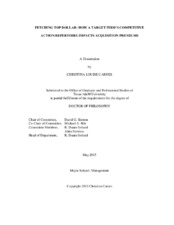| dc.description.abstract | In this dissertation, I integrate signaling and holistic processing theories to examine how the pattern characteristics of a target firm’s competitive actions over time can influence its acquisition premium by reducing information asymmetry. Currently, our knowledge of acquisitions and accompanying premiums is dominated by acquirers’ concerns and little is known about how a target firm can influence its value in the eyes of potential buyers. Signaling theory has been used to help examine this issue, but overall applications have remained similar and largely cross-sectional in nature. My research builds on signaling theory and holistic processing theory to suggest patterns in a firm’s competitive action repertoire provide current and historical information that can reduce information asymmetries for potential acquirers.
Specifically, I develop theory to predict that target firms with competitive action repertoires exhibiting high simplicity, similarity, and predictability will be associated with high acquisition premiums. I also consider both firm and environmental level characteristics that may potentially moderate these relationships. My results support the underlying assertion in my model, that competitive action repertoire characteristics influence acquisition premiums; but, I find conflicting effects depending on the specific characteristics. Further, I do not find any support for my proposed moderating effects. Theoretical and empirical implications of the research are discussed.
Specifically, I develop theory to predict that target firms with competitive action repertoires exhibiting high simplicity, similarity, and predictability will be associated with high acquisition premiums. I also consider both firm and environmental level characteristics that may potentially moderate these relationships. My results support the underlying assertion in my model, that competitive action repertoire characteristics influence acquisition premiums; but, I find conflicting effects depending on the specific characteristics. Further, I do not find any support for my proposed moderating effects. Theoretical and empirical implications of the research are discussed. | en |


